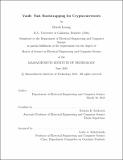| dc.contributor.advisor | Nickolai B. Zeldovich. | en_US |
| dc.contributor.author | Leung, Derek (Derek Ting-Haye) | en_US |
| dc.contributor.other | Massachusetts Institute of Technology. Department of Electrical Engineering and Computer Science. | en_US |
| dc.date.accessioned | 2018-09-17T14:51:03Z | |
| dc.date.available | 2018-09-17T14:51:03Z | |
| dc.date.copyright | 2018 | en_US |
| dc.date.issued | 2018 | en_US |
| dc.identifier.uri | http://hdl.handle.net/1721.1/117821 | |
| dc.description | Thesis: S.M., Massachusetts Institute of Technology, Department of Electrical Engineering and Computer Science, 2018. | en_US |
| dc.description | This electronic version was submitted by the student author. The certified thesis is available in the Institute Archives and Special Collections. | en_US |
| dc.description | Cataloged from student-submitted PDF version of thesis. | en_US |
| dc.description | Includes bibliographical references (pages 63-65). | en_US |
| dc.description.abstract | Decentralized cryptocurrencies rely on participants to keep track of the state of the system in order to verify new transactions. As the number of users and transactions grows, this requirement places a significant burden on the users, as they need to download, verify, and store a large amount of data in order to participate. Vault is a new cryptocurrency designed to minimize these storage and bootstrapping costs for participants. Vault builds on Algorand's proof-of-stake consensus protocol and uses several techniques to achieve its goals. First, Vault decouples the storage of recent transactions from the storage of account balances, which enables Vault to delete old account state. Second, Vault allows sharding state across participants in a way that preserves strong security guarantees. Finally, Vault introduces the notion of stamping certificates that allow a new client to catch up securely and efficiently in a proof-of-stake system without having to verify every single block. Experiments with a prototype implementation of Vault's data structures show that Vault reduces the bandwidth cost of joining the network as a full client by 99.7% compared to Bitcoin and 90.5% compared to Ethereum when downloading a ledger containing 500 million transactions. | en_US |
| dc.description.statementofresponsibility | by Derek Leung. | en_US |
| dc.format.extent | 65 pages | en_US |
| dc.language.iso | eng | en_US |
| dc.publisher | Massachusetts Institute of Technology | en_US |
| dc.rights | MIT theses are protected by copyright. They may be viewed, downloaded, or printed from this source but further reproduction or distribution in any format is prohibited without written permission. | en_US |
| dc.rights.uri | http://dspace.mit.edu/handle/1721.1/7582 | en_US |
| dc.subject | Electrical Engineering and Computer Science. | en_US |
| dc.title | Vault : fast bootstrapping for cryptocurrencies | en_US |
| dc.title.alternative | Fast bootstrapping for cryptocurrencies | en_US |
| dc.type | Thesis | en_US |
| dc.description.degree | S.M. | en_US |
| dc.contributor.department | Massachusetts Institute of Technology. Department of Electrical Engineering and Computer Science | |
| dc.identifier.oclc | 1051460694 | en_US |
